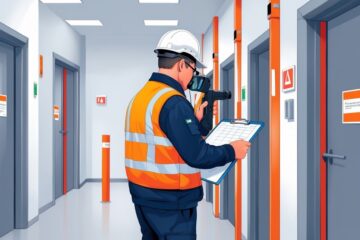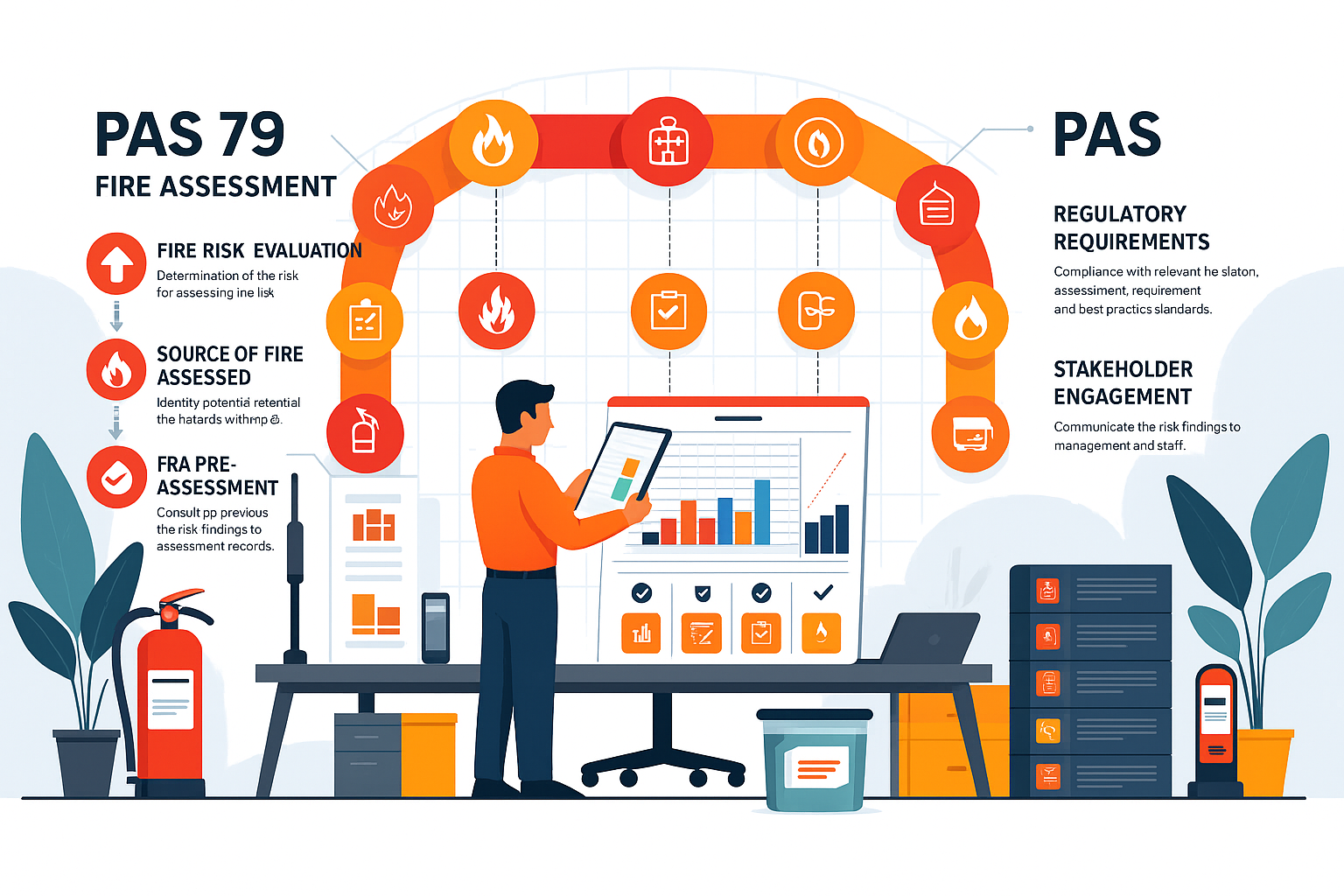Why small things matter (quick story)
Conducting an Office Fire-Risk Assessment is crucial to identify potential hazards and ensure safety.
Last April, Gina, the facilities lead for a quirky media studio in Shoreditch, got the scare of her life. A cheap four-way extension behind the podcast desk fizzed, popped, and smoked. No flames—thank goodness—but the smell of melting plastic shut the floor for half a day. The engineer’s verdict? “Too many gadgets, wrong rating, no inspection.” It cost £ 9,000 in downtime, not to mention Gina’s nerves.
Understanding risks through an Office Fire-Risk Assessment can help prevent unexpected incidents.
That one cable tells a bigger tale: office fires rarely start with Hollywood explosions. They start with the stuff we miss because we’re busy fixing printers and booking meeting rooms. Let’s hunt down seven sneaky hazards hiding in plain sight.
1. The overloaded-socket case no one wants to own
See that desk cluster in Croydon? One twin wall plate, five hungry laptops, two phone chargers, a kettle (yes, really), and a space heater in winter. Add a dust bunny, and you’ve got a slow-cooked recipe for an electrical short.
Why it happens
- New hires arrive faster than planned power upgrades.
- Portable heaters show up the minute the HVAC feels chilly.
- Nobody checks amp ratings; 13-amp strips end up feeding 20-amp loads.
What to do—simple words
- Map sockets on a floor plan. Colour red if more than three plugs live there.
- Swap cheap strips for fused, surge-protected ones.
- Book an electrician to add extra outlets before winter.
- Teach staff: kettles and heaters live on their own outlet—no sharing.
Seasonal tip: Cold snaps in January send heater use soaring. Send a reminder email in the first week of the new year.
2. Paper storage—the slow burn in the copy room
Remember when we all said offices would go “paperless”? Yet the cupboard beside the copier in Bromley holds six knee-high stacks of archived invoices. Paper is tinder. One spark and you’re in trouble.
Hidden triggers
- Flickering fluorescent starter.
- Overheated printer fuser.
- Careless lunchtime candle (yes, we’ve seen it).
Fixes in five lines
- Keep paper in closed metal cabinets.
- Clear “to-shred” trays every Friday.
- Service printers every six months—swap worn fusers.
- Ban naked flames; use battery tea lights for that “cosy” vibe.
- Fit a heat detector above the print zone, linked to the main panel.
3. Hot-desk layouts and the wandering charger maze
Hot-desking feels slick—move, plug, go. But random layouts confuse escape paths and, worse, hide chargers under chairs.
Risks
- Trip hazard during evacuation.
- Power bricks trapped under seat pads overheat.
- Staff sit far from the call-point they’re meant to test on Fire Drill Friday.
Smart tweaks
- Mark a clear 1.2 m gangway with floor tape. No desks, no plants, no storage.
- Install “power islands” in the floor—fewer trailing leads.
- Pin a laminated card to every column: “Nearest call-point → 4 steps east.”
- Rotate desk locations only after the fire plan updates.
Note: In open-plan hubs like Manchester Spinningfields, landlords may insist on fixed “sterile strips” across shared floors. Check your lease.
4. Disabled egress—easy to promise, hard to prove
Lifts can’t be used in fire, yet many offices rely on them for staff with mobility needs. A single missing evac chair can strand a colleague.
Where it breaks down
- Chair stored three floors away.
- No one trained to use it.
- Refuge area intercom disconnected.
Your action list
- Count mobility-impaired staff and visitors—include pregnant employees late in term.
- Provide one evac chair per stair core above ground.
- Schedule hands-on practice every quarter (put it in the HR learning portal).
- Test refuge phones monthly. Log faults in the fire book.
Local fire officers in Leeds now ask to see the chair log during audits—be ready.
5. Cables in the ceiling void—the silent ember
Ceiling tiles hide sins: bundled Cat-6, power, PA, and fairy lights left from last Christmas. Over time, insulation rubs off and sparks drop into soft furniture below.
Quick scan
- Pop tiles on a stick ladder.
- Feel if the cables are warm.
- Sniff: scorched PVC has a sweet, sickly smell.
Mitigation
- Reroute high-current lines in metal trunking.
- Remove fairy lights after events.
- Ask IT to bundle data lines neatly with Velcro straps, not plastic ties (they cut).
6. Kitchen corners—the oily danger after offices close
Small break rooms cook up big fires. Oil-soaked filter pads, crumb piles inside toasters, and microwaves full of popcorn residue—ripe fuel.
Checks
- Clean filters weekly (stick a chart on the wall).
- Empty crumb trays every Friday.
- Provide CO₂ extinguisher plus fire blanket near the door, not behind the hob.
- Install a 30-minute fire-rated door with a closer. Keep it shut.
Summer sees more iced-latte hacks using milk frothers and mini hobs. Remind teams before July holiday season.
7. Dead extinguisher zones—great kit, wrong spot
You bought shiny new red cans. But two years later, the office move means the CO₂ sits behind a locked meeting room. If a charger sparks in reception, the staff run three corridors searching.
Audit steps
- Walk the escape route with fresh eyes.
- Extinguishers must be:
- Visible from any point (or signposted within 30 m).
- Mounted 1 m from the floor.
- Matching the risk (CO₂ for electrics, foam for rubbish bins).
- Tag each one with next service date.
- Update the plan the same day you shift furniture.
Action Matrix: spot the hazard—pick the fix
| Hazard | Likely Cause | Risk Level (H/M/L) | Quick Win (24 h) | Longer Plan (30 days) |
|---|---|---|---|---|
| Overloaded sockets | Too many heaters | H | Unplug heaters; stick warning tag | Add new circuits; PAT test strips |
| Paper piles | No shred routine | M | Box & store in metal cabinet | Digitise files; set shred schedule |
| Hot-desk chaos | No fixed paths | M | Clear gangway lines today | Install floor power islands |
| Disabled egress | Missing evac chair | H | Borrow chair from ground floor | Buy extra chair; staff training |
| Ceiling void cables | DIY lighting | M | Remove fairy lights | Metal tray & yearly inspection |
| Greasy kitchen | Dirty filter | H | Clean filter & crumb tray | Monthly cleaning contract |
| Hidden extinguisher | Office refurb | M | Re-site extinguisher | Re-survey every move |
Print, laminate, and stick it in the FM cupboard. Simple.
Putting it all together
You don’t need a PhD in fire science. You need sharp eyes, a checklist, and the will to nudge people. Take Gina’s lesson: one socket, big headache. Catch these seven hazards now, and you’ll save money, reputation, maybe lives.
Walk your floor this week. Mark sockets, peek above tiles, count chairs. Fix the worst bits first. A little sweat today beats smoke tomorrow.
Need a deeper audit?
Grab our Ultimate Office Fire-Assessment Guide—packed with template logs, UK legal pointers, and seasonal reminders. Or ring us on 020 3920 9617 for a quote. We’ll walk the site, share plain-English fixes, and email the report before the kettle boils.
Stay safe, stay open.


